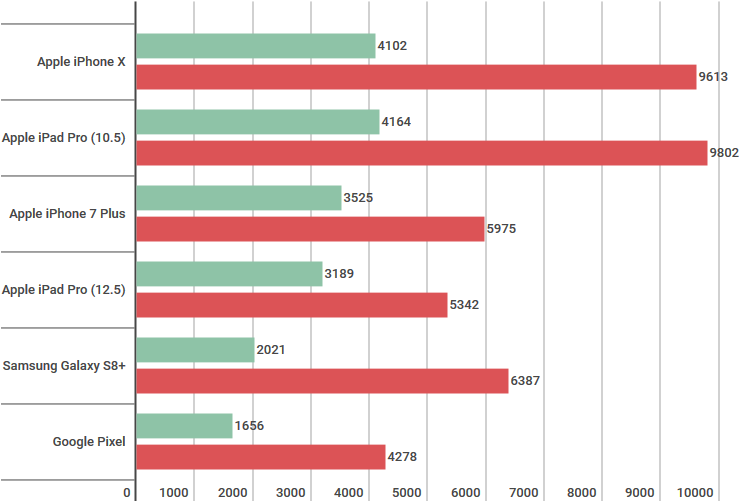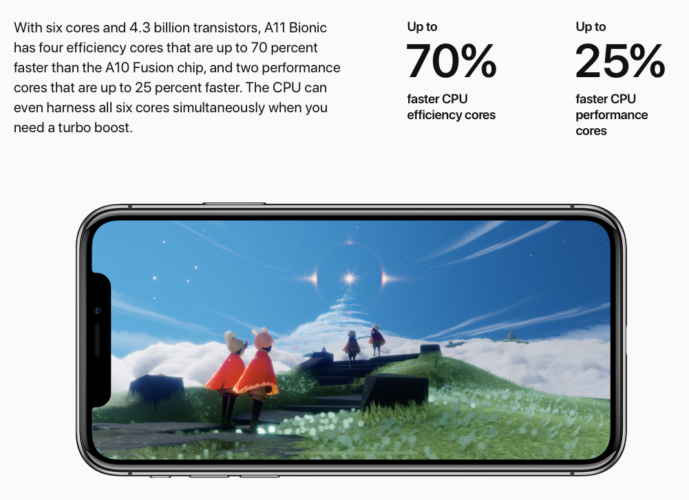It's only been a year since iPhone 7 debuted with the A10 Fusion processor, which other devices have only recently been able to catch up with. However, Apple has already raised the bar by using the new A11 Bionic processor for iPhone X, iPhone 8 and iPhone 8 Plus, which is now the most fast mobile processor.

The new A11 processor not only outpaced the A10X Fusion in iPad Pro, but also caught up with the 13-inch MacBook Pro processor Intel.
Geekbench's John Poole says the two test processors perform almost equally. The two full-power A11 cores run at 2.5Hz and the A10 Fusion CPU cores run at 2.34Hz.

The tested devices run on iOS 11.1, so either this version of the system will be installed on iPhone X right away, or it is still being tested by company employees.
Each core of the A11 Bionic processor scored from 4,100 to 4,274 points in the benchmarks, and the entire processor reached 10,430 points.
For comparison, the cores of the A10X Fusion processor averaged 3,887 points, for a total of 9,210. iPhone 7 with the A10 Fusion processor scored 3,327 points for a total of 5,542.
The 13-inch MacBook Pro with a dual-core Intel 3.5Hz processor scored 4.592 and 9.602 points – and we are talking about the whole laptop!
Another comparison: MacBook Pro with a 2.3Hz processor scored 4.321 and 9.183 points, while a 3.1Hz processor scored 4.227 and 8.955.
This is impressive. Such large numbers should be intimidating not only Android, but Intel along with other processor manufacturers like Qualcomm and Samsung.
Previous A-series processors Apple outperformed the competition on a per-core basis, but the A11 Bionic isn't just fast, it's a monster among multi-core processors.
The processor contains two additional energy-saving cores, i.e. now there are four of them. They are used for missions that do not require full speed. For example, checking mail, listening to songs, performing background tasks, etc. The processor also contains two full-power cores for editing videos, games, and more.

The A10 Fusion processor could not use different kinds of cores at the same time, and in the A11 Bionic, all the cores are independent of each other and can work at the same time.
In addition, the A10 Fusion processor divides the cores into two zones of equal size (two 'large' and two 'small'), and the system can only use these zones in turn.
In other words, iPhone 7 should switch from powerful cores to energy efficient and vice versa every time, and iPhone X can use both at the same time.
… This sounds like it's going to be a Geekbench monster. RIP the rest of the industry
– Steve T-S (@stroughtonsmith) September 10, 2017
Apple says the full power cores of the A11 Bionic are 25% faster than the A10 Fusion and are 70% more energy efficient.
“The new processor control can use all six cores at the same time and thus run 70% faster,” says Apple.
Analyst Dan Matt believes that the processor was able to achieve this speed by getting rid of 32-bit support (therefore Apple will remove support for 32-bit applications by iOS 11):
If 32-bit support had not been removed from the processor, it would have been made faster by only 15%, and it would not have been much better than the A10 Fusion processor.
Apple could have made the cores even more powerful if not for the 10nm manufacturing process. The era of Moore's Law is officially over, but it was clear with the A10 Fusion. Now everything is being built in the foundry.
The A11 processor contains the Secure Enclave cryptographic coprocessor, and for the first time Apple has developed its own GPU, which is 30% faster than the A10 Fusion.
The test results do not have to be consistent with the performance of the device in daily use, as various factors can affect the speed of the processor in operation.
But, given that the A11 processor has taken the leading position, these results should be noticeable in the work with the latest version of the operating system Apple, and they should not consume a lot of RAM.
